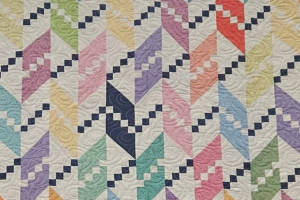LOCAL FLAVOR: “Ozarks at Large” digs deep to bring you stories you won’t hear anywhere else.

WORDS / SUSAN PORTER
PHOTO / KAT WILSON
Back in the ‘70s and early ‘80s – if you wanted to spin some wax and have a show on KUAF 91.3, all you needed was a good vinyl collection or friends who did. That was when KUAF was the University of Arkansas operated 10-watt wonder. Those were the days when you knew everyone you saw on Dickson Street and KUAF was unique to Fayetteville. Unique because that was as far as the airwaves could take it. The program was locally produced and it was pretty much an all volunteer operation. Sometimes the shows were thrown together at the last minute and it showed. Today things are vastly different.
KUAF is now a 100,000-watt station that jumps the Ozark Mountains and can be heard throughout Northwest Arkansas, the River Valley and in some parts of Oklahoma and Missouri. Things began changing at KUAF in 1985. That’s when the little station began its transition from local to professional and became an NPR affiliate. NPR syndicated feeds filled the airwaves with slick programming and news from around the world. The reggae show and other volunteer-produced shows went by the wayside. Amazingly, two shows from those early days — Mike Shirkey’s “The Pickin’ Post” and Robert Ginsburg’s “Shades of Jazz” — survived the transition and remain extremely popular.
Gradually, KUAF has added back more local shows, many produced by KUAF staffers. One of the local programs that has brought the “local” back is “Ozarks at Large” with long-time news director Kyle Kellams at the helm. The one-hour, six-day-a-week news magazine has a staff of professional reporters that dig for obscure features on Ozark people and places as well as news stories that go largely unreported.
One of those features was Jacqueline Froelich’s story about African American history in the Ozarks. Two years after Froelich’s first story aired on “Ozarks at Large,” she unearthed a story about the racial cleansing of Harrison – a story that had been buried from more than a century. Her top-notch reporting led to a two-hour documentary. Froelich joined the show in 1996 and is now a senior news producer and station-based NPR correspondent. She credits Kellams for opening the door to her career.
“My degree was in print journalism, not broadcast, so I had no idea what I was doing. Plus my scripts were far too elaborate. But he quickly, and kindly, taught me the radio ropes,” she said.
In 1989, KUAF was in a small house on Duncan Street where “we were stumbling over each other.” Interviews were recorded on tape and editing was done with razor blades. “You couldn’t be too creative because if you didn’t like the edit you just created, you would have to splice it back in,” Kellams said. “Now you can try something and restore it in mere seconds.”
Although Kyle Kellams and “Ozarks at Large” are somewhat synonymous, the show’s name was first used for a 30-minute weekly interview program hosted and produced by Dave Edmark and James Russell. Like many of the shows produced during those early days, Edmark and Russell were volunteers. They stopped producing the program in 1990. When station manager Rick Stockdell asked Kellams to takeover the program, Kellams balked.
“I didn’t have the confidence to sit down with someone for 30 minutes. I was 26.” Kellams said. But with the seed planted, Kellams grabbed his notebook and headed for Jerry’s Restaurant (formerly at the southwest corner of Dickson Street and College Avenue) and ordered lots of coffee.
That’s where “Ozarks at Large,” as we know it today, was created. Kellams formulated the idea for a program that would involve several different elements. The program launched in 1990 as a 30-minute show, with Kellams doing most of the work and reporting. Within a year it became an one-hour production that aired on Friday night and Saturday morning. The show went daily in 2010. For Kellams, one of the biggest changes since taking it from a weekly program to a daily is “the chance I won’t come up for air…we’re never really able to get too comfortable.”
It’s pretty safe to say that “Ozarks at Large” is unique and at the top of the heap when it is compared to programs in other NPR markets of the same size or even larger. Kelllams said every station in every market is different and decides how to allot their time and resources. He surveyed what some of the other stations were doing a few years ago and found that some had weekly programs similar to “Ozarks at Large,” but really nothing like it. He said the success of the show is based on three factors: A general manager (Stockdell) who is committed to local programming, “an incredibly devoted, energetic and intelligent” staff and an audience that loves stories and public radio and supports programs like it.
Kellams is quick to credit Froelich and the other “Ozarks at Large” contributors Antoinette Grajeda, Christina Karnatz, Timothy Dennis and Sara Burningham with the success of the program.
“We constantly have conversations about what we want to accomplish with the show,” Kellams said. “We concentrate on things we do best: sound, stories that benefit from more time on the air, pieces that maybe others don’t do.”
One of the appealing elements of the show is the variety of reporting. The contributors cover news, politics, education, sports, art and culture and the quirky and unusual stories that are specific to the Ozarks. The crew frequently steps outside their comfort zone in the downtown Fayetteville studio to travel to small towns with a population of two digits or to the Ivory Tower of the university to report a story of interest.
Some of the more memorable stories for Kellams are reporting on the simultaneous emergence of cicadas in rural Washington County for the first time in hundreds of years, recording musicians inside an empty Fayetteville water tank, covering the Pea Ridge Mule Jump, and Miller Williams’ story of having a drink with Hank Williams.
Since that day some twenty-odd years ago when Kellams sat in a booth at Jerry’s Restaurant and came up with the format for OAL, the popularity of the show and the public admiration of Kellams has turned him into one of the most in-demand hosts in Northwest Arkansas. He’s volunteered his time to act as a panel moderator for all sorts of topics and as an emcee for a multitude of non-profit fundraisers and events like the Fayetteville Roots Festival and the Northwest Arkansas Music Awards. A straight-talking, down-to-earth guy who’s always ready with a question, Kellams is a quick wit and never intimidates. Although he would eschew the word “celebrity,” in this little corner of the world he is, no matter how hard he tries to let the limelight bounce off. He never slows down at the studio and continually strives to better the show’s programming.
“I’d hope a listener, whether a resident of the region for 70 years or a week, gets a little bit better understanding of where she or he lives. We want to make sure voices of different kinds of people are on the air. We get art, news and ideas in every program,” Kellams said.
Where does it go from here? “Ozarks at Large” does a couple of shows a year with on-location live audiences and Kellams says they would like to do more. He again tips his hat to the staff: “We’re certainly not limited by our collective imaginations.”
Froelich added, “Ozarks at Large will endure as a remarkable trove of stories about Ozarks people, personalities, and places.”
FOLLOW: @OZARKSATLARGE





Comments